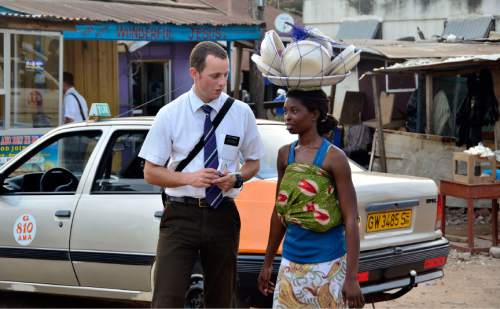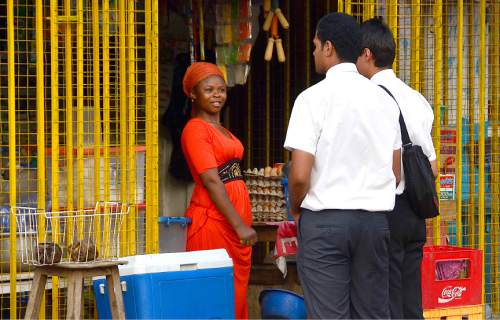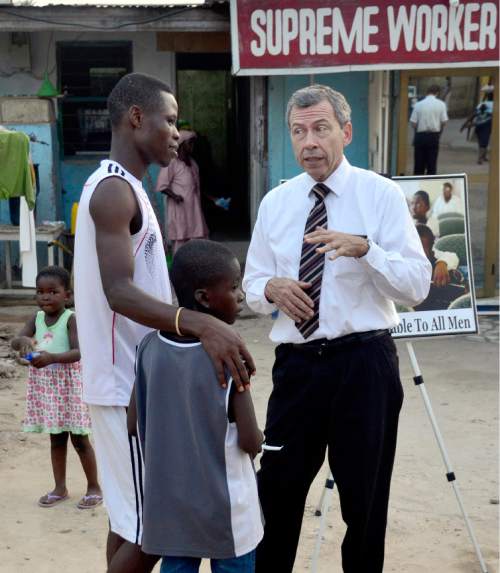This is an archived article that was published on sltrib.com in 2015, and information in the article may be outdated. It is provided only for personal research purposes and may not be reprinted.
Religious demographers one day may view 2014 as the year that some trends in LDS growth — or the lack of it — were reversed.
Or at least a year of surprises, says Matt Martinich, a Colorado researcher who tracks Mormon statistics.
"No one was expecting the number of missionaries to remain around 88,000" after the so-called "surge" ended, says Martinich, who served an LDS mission to South Korea from 2004 to 2006.
In 2012, the Utah-based Church of Jesus Christ of Latter-day Saints lowered the minimum age for male missionaries from 19 to 18 and for females from 21 to 19. New proselytizers flooded the volunteer system, swelling the missionary force from 58,000 to nearly 90,000, but most people expected that number to level off in the mid-70,000s.
That didn't happen, Martinich notes. "It's partly because members from outside the U.S. now are serving in record numbers. It's amazing progress."
Another key development this year has been "the most rapid growth in the number of stakes [regional units composed of multiple LDS congregations] since 1998," the independent demographer says in a phone interview, which signals "improved retention and maturing local leadership" in the 15 million-member faith.
On the downside, Martinich points to declining congregational numbers in parts of South America and Mexico.
"It is very worrisome," he says.
Martinich recently posted at cumorah.com what he sees as the "Top 10 Encouraging and Discouraging LDS Growth and Missionary Developments of 2014."
On the positive side, the church:
• Maintained the size of its peak full-time missionary force, partly due to the dramatic rise in the number of non-U.S. Mormons serving missions.
• Saw its most rapid growth in the number of LDS stakes in more than 15 years, organizing at least 64 new stakes and discontinuing only one. The largest all-time net annual increase in the number of stakes occurred in 1996, when the church reported a net increase of 146 stakes.
• Experienced rapid growth in West Africa, including some 20,000 converts and an impressive net gain in the number of congregations as well. An Ivory Coast stake, with only African members serving as missionaries, mushroomed from eight wards at the start of 2014 to 15 wards and one branch.
• Created its first stakes in Albania, Federated States of Micronesia, Cambodia and Jamaica.
• Reversed stagnant growth in Hong Kong, Macau and Taiwan, areas that had seen congregational declines in the 2000s.
• Continued an aggressive outreach campaign in Brazil, opening to missionary work 63 cities and towns where the church previously had no presence.
• Racked up significant growth in the Philippines, with a net increase of 32 congregations, the largest bump there since 2001. From August 2012 to June 2014, the number of full-time missionaries assigned to the Philippines jumped from 2,380 to 4,482 — of which 2,383 were Filipinos.
• Obtained official recognition from the Vietnamese government. The church also reclassified its presence there from sensitive to nonsensitive in December 2014, permitting Internet users to search for LDS meetinghouse locations in the Southeast Asia nation.
• Assigned its first young, full-time missionaries to Burma and Gabon. Full-time proselytizers also returned to Sri Lanka, which had been closed to missionaries since 2008 because of visa-renewal problems.
• Allowed the first LDS General Conference addresses to be given in languages other than English.
On the negative side, the church:
• Saw congregational decline continue in Colombia, Paraguay, Peru and Venezuela and speed up in Argentina, Chile, and Uruguay.
• Experienced no net change in the number of official congregations in at least 106 countries and dependencies.
• Had little "real" growth in Mexico — despite creating eight new missions there in 2013.
• Posted steady congregational dips in Japan and South Korea.
• Continued to shrink in Papua New Guinea's capital of Port Moresby.
• Made minimal to no progress in national outreach in several southeast African countries.
• Recorded no noticeable progress in expanding its presence in India.
• Added only two new missions — despite the higher number of missionaries. The average mission had 217 missionaries by October 2014 compared with the historical average of 163 from 1979 to 2011. If the church were to maintain this historical average, it would need to create an additional 134 missions.
• Closed the Ukraine Donetsk Mission due to political unrest, evacuated all missionaries there and discontinued its four branches in Donetsk.
• Removed all 274 missionaries from Liberia and Sierra Leone. LDS officials have not indicated when any will be reassigned there.
Though Martinich — co-author of a 1,900-page, two-volume, exhaustive survey, titled "Reaching the Nations: International Church Growth Almanac 2014" — taps official LDS sources for his data, he acknowledges the study's limitations.
Assessing the impact of these missionary and growth developments, the researcher says, always will be "subjective."
Twitter: @religiongal













